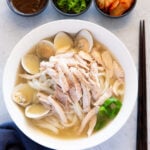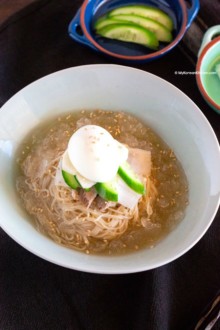This cozy Korean chicken noodle soup — called dak kalguksu (닭 칼국수) or sometimes chicken kalguksu — is one of my favorite comfort meals. It features tender chicken, knife-cut noodles, and a light yet flavorful broth that feels especially soothing on cold or rainy days. It’s simple, nourishing, and easy to make at home.
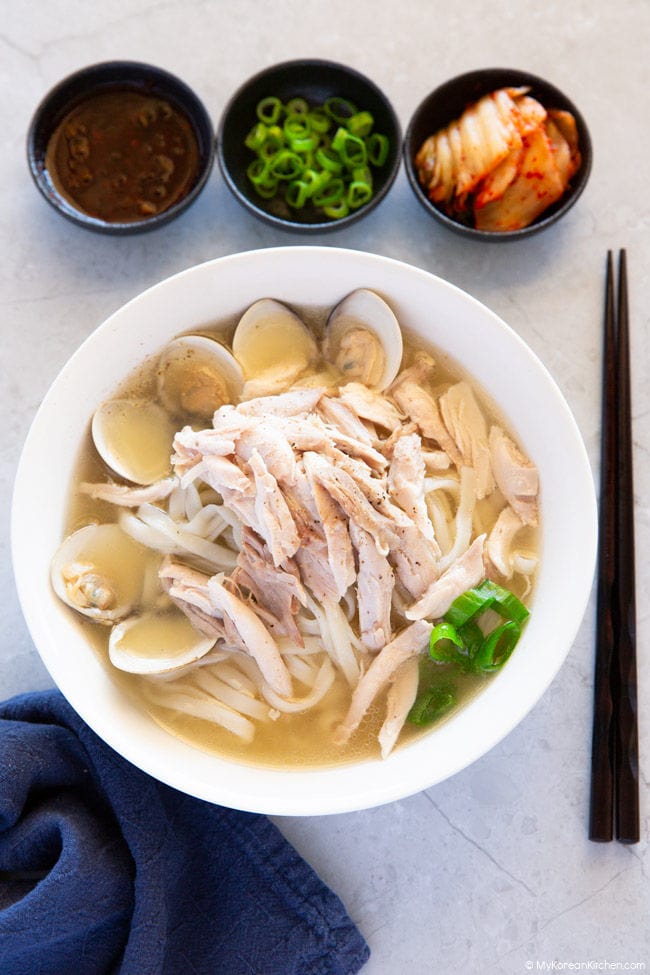
What is Dak Kalguksu
Dak Kalguksu (닭 칼국수) is a traditional Korean dish that translates to “chicken knife-cut noodle soup.” In Korean, “dak” means chicken, and “kalguksu” refers to noodles that are hand-cut with a knife rather than machine-made.
This cozy and nourishing soup features tender chicken and soft, flat noodles simmered in a clean, flavorful broth. It’s comforting, satisfying, and one of the most beloved types of Korean chicken noodle soup.
In Korea, dak kalguksu is sometimes enjoyed as a stamina-boosting meal, especially during the summer. Like samgyetang (Korean ginseng chicken soup), it’s tied to the traditional belief of 이열치열 (yi yeol chi yeol) — fighting heat with heat. On hot, humid days, it’s not unusual to see people slurping this steaming soup, sweat on their brows, smiling through the heat. Sounds intense, right? 😅
Still, no matter the season, chicken kalguksu brings that homey feeling — warm, gentle, and full of flavor. Whether you’re feeling under the weather or just need a little comfort, it’s one of those meals that always delivers.
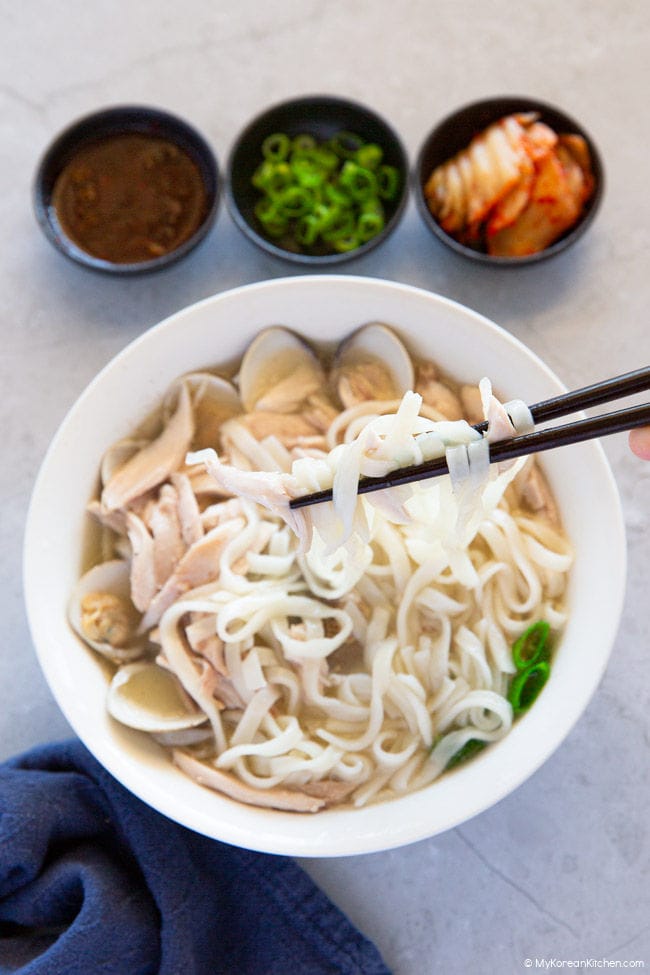
A Fresh Take on Dak Kalguksu
The broth for traditional kalguksu is usually made with dried anchovies and dried kelp, creating a clean, ocean-infused flavor. But with dak kalguksu, chicken takes center stage — simmered slowly to create a light yet deeply comforting base.
Some restaurants even take it a step further, adding ginseng or oriental herbal ingredients to enhance the stamina-boosting qualities of the dish. These broths are often simmered for hours to draw out all the flavor and nutrients — making each bowl as nourishing as it is delicious.
Now, you might be wondering: what’s different about my version? When I first shared this recipe back in 2013, I focused entirely on the chicken broth. But during a recent trip to Korea, I had a bowl that completely changed my perspective. It was bright, clean, and refreshing — made with both chicken and a small amount of dried anchovies and littleneck clams. The combination was so flavorful and balanced, I knew I had to bring that updated version to My Korean Kitchen.
Traditionally, kalguksu includes vegetables like zucchini, carrots, or potatoes. But dak kalguksu often keeps it simple with just green onion — which means the broth really has to shine. That’s where this upgraded version comes in: layered, light, and satisfying with every spoonful.
My Best Cooking Tips
Chicken Back (Chicken Frame)
Use chicken backs, also known as chicken frames! They’re an incredibly economical ingredient that produces a deep, comforting soup.
Chicken backs (or chicken frames) refer to the carcass of the chicken — mostly bones and cartilage, with some leftover meat attached. They’re often used to make soup stock because of the rich flavor they bring to the broth.
I used to use a whole chicken for this soup, but now I actually prefer chicken backs. They give the broth great depth and save me from chewing through the parts I don’t enjoy as much (like chicken breast). It’s also easier to handle — no need to debone anything.
For the actual meat in dak kalguksu, I typically use chicken drumsticks. They’re tender, flavorful, and come with extra bones to enrich the soup even more.
Kalguksu Noodles and Substitutes
Kalguksu noodles are traditionally made by combining wheat flour and water, then rolling the dough out and slicing it into long, flat strands with a knife—hence the name, which means “knife-cut noodles.” Some people also add an egg for extra richness. These noodles are known for their soft but pleasantly chewy texture, which holds up beautifully in hot broth.
You can easily find kalguksu noodles at most Korean grocery stores. They’re sold in both dry and fresh forms, with the fresh version usually found in the refrigerated or freezer section. For convenience, I often use store-bought, but I also love making them from scratch when I have time. If you’d like to try homemade noodles, check out my homemade kalguksu noodle recipe.
And if you can’t find kalguksu noodles near you or don’t want to make them from scratch, here are a few good alternatives:
Udon Noodles: These Japanese noodles are made from wheat flour, just like kalguksu, and come in both fresh and dried forms. Kishimen, a flat style of udon, also closely resembles kalguksu in shape and texture.
Sujebi Noodles: These are hand-torn Korean noodles with a rustic, uneven look. While they aren’t long strands, they work well in this soup and offer a similar chewy, comforting bite. You can find my Sujebi recipe here.
Chinese Knife-Cut Noodles (Dao Xiao Mian): These are shaved from a block of dough and share a similar thickness and handmade feel. I haven’t tried them personally in this soup, but from what I’ve read, they could be a great substitute.
Keep in mind that while these noodles have similar characteristics, the flavor and texture may vary slightly depending on the ingredients and how they’re prepared.
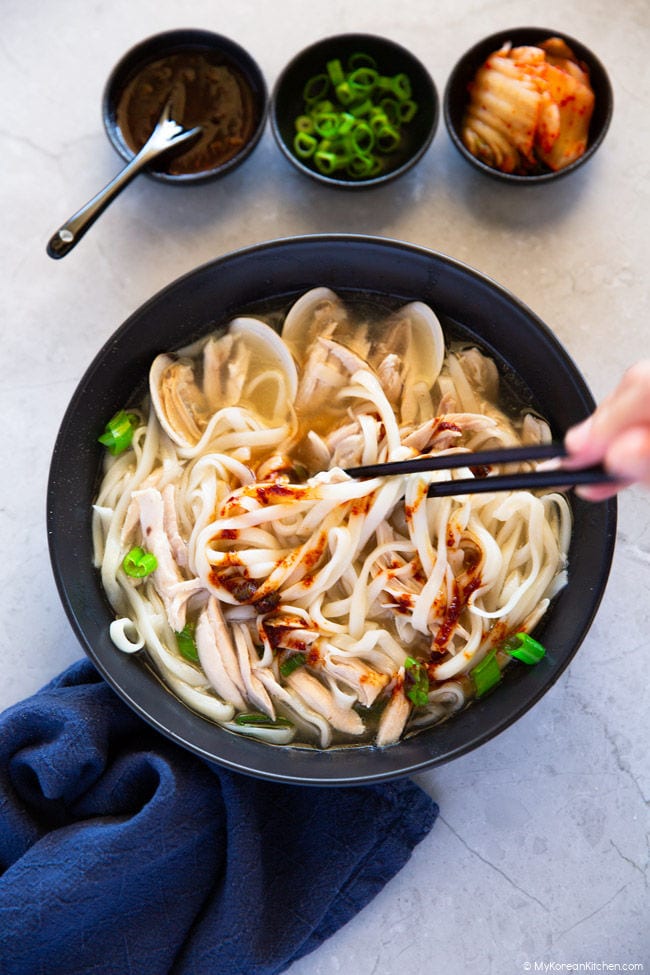
Ingredients for Chicken Kalguksu
Soup Base
- 1kg / 2.2 pounds chicken backs (chicken frames)
- 110g / 3.9 ounce onion
- 50g / 1.8 ounce green onion, white part
- 15g / 0.5 ounce garlic cloves
- 50g / 1.8 ounce dried anchovies
- 1/2 tsp whole black peppers
- 12 cup water
Main
- 1kg / 2.2 pounds chicken drumsticks
- 300g / 10.6 ounce little neck clams, rinsed
- 400g / 14.1 ounce kalguksu noodles (or udon noodles, *see above for more options)
- 1 tsp Korean soup soy sauce or kikkoman soy sauce
- 3/4 tsp fine sea salt, or to your taste
Topping (Optional)
- 30g / 1 ounce green onion, thinly sliced
Seasoning Sauce (Optional)
- 1/4 cup soy sauce, regular (I use kikkoman brand.)
- 1 Tbsp Korean chili flakes (gochugaru)
- 1/2 Tbsp honey
- 1 Tbsp green onion, thinly sliced
- 1 tsp minced garlic
- 1 tsp sesame oil
* 1 Tbsp = 15 ml, 1 Cup = 250 ml
** If you’re interested in learning more about Korean ingredients, check out my essential list of Korean cooking ingredients.
How to Make Korean Chicken Noodle Soup
1. Place the chicken backs in a large pot along with the other soup base ingredients and water. To make cleanup easier later, you can use a stock bag (also called a soup sock), typically made of fine mesh or cheesecloth, to hold the solid ingredients. If your bag isn’t large enough to fit everything, focus on enclosing the anchovies, garlic, and black pepper—these are the trickiest to remove later.
Bring everything to a boil over medium-high heat, which should take about 25 minutes. Once it reaches a boil, carefully add the chicken drumsticks to the pot. Continue cooking at the same heat for another 25 minutes.
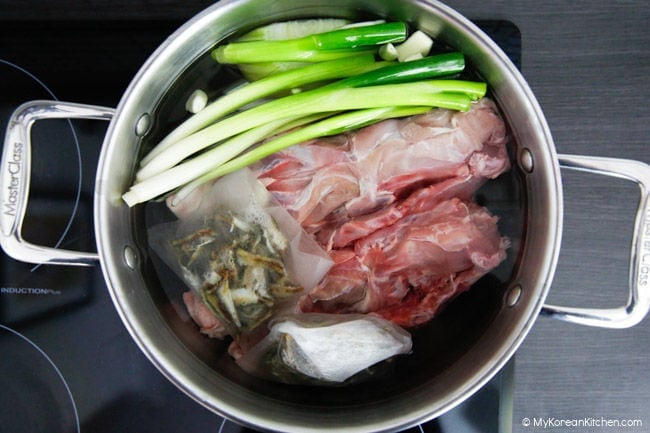
2. Lower the heat to medium-low and let the broth simmer for another 30 minutes. Skim off any foam or fat that rises to the surface to keep the broth clear.
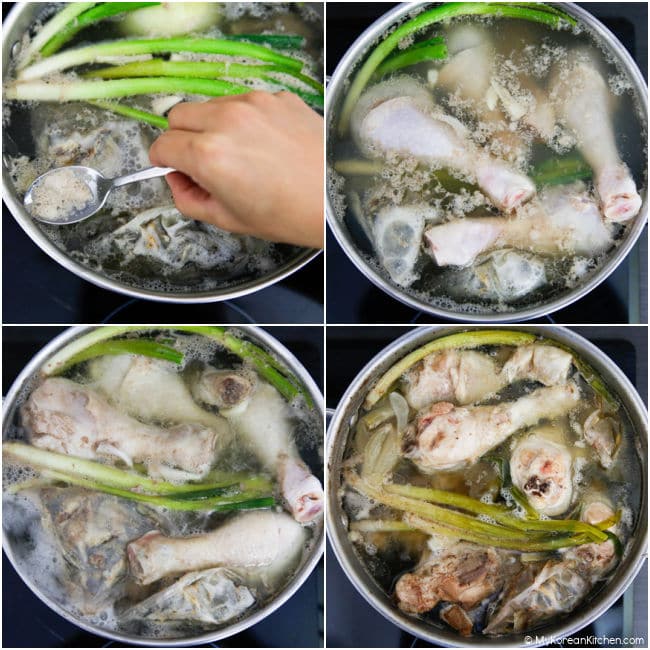
3. Remove the soup base ingredients from the broth. Set the chicken drumsticks aside in a separate bowl to cool. Once cooled, remove the skin and bones, then tear the meat into bite-sized pieces. Set aside until ready to serve.

4. In another large pot, pour in the broth and bring it to a boil. Add the littleneck clams and Korean soup soy sauce, then season with salt to taste.
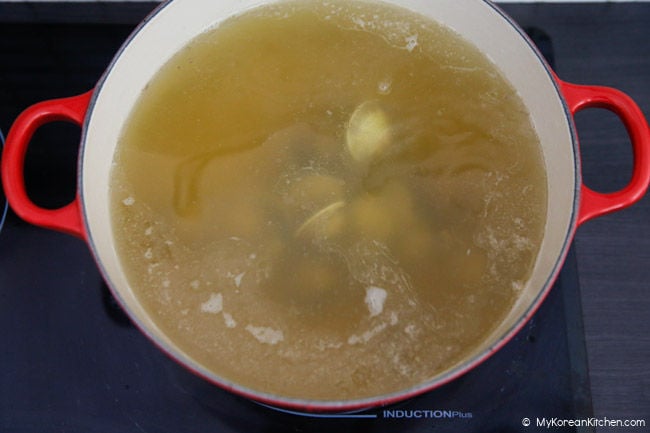
5. Briefly rinse the kalguksu noodles under cold running water to remove excess starch. Add them to the boiling broth and cook over medium heat for 3–5 minutes, or until fully cooked.

6. Meanwhile, mix the optional seasoning sauce ingredients in a small bowl and set aside.

7. Serve the soup piping hot, topped with the prepared chicken and green onions. You can enjoy it as is, or add a spoonful of the seasoning sauce to enhance the flavor to your taste.
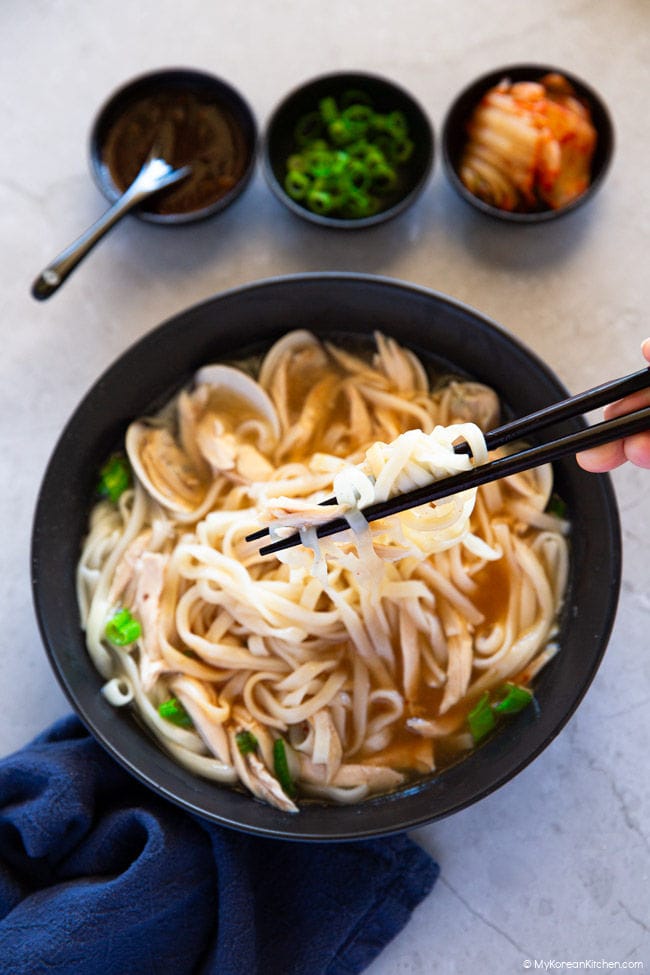
Other Korean Noodle Recipes You Might Like
If you enjoyed this chicken noodle soup, I think you’ll love these other noodle recipes too. Each one is comforting in its own way — definitely worth checking out!
- Sujebi (Korean Hand Pulled Noodle Soup)
- Kalguksu (Knife Cut Noodle Soup)
- Janchi Guksu (Banquet Noodle Soup)
- Jjampong (Spicy Seafood Noodle Soup)
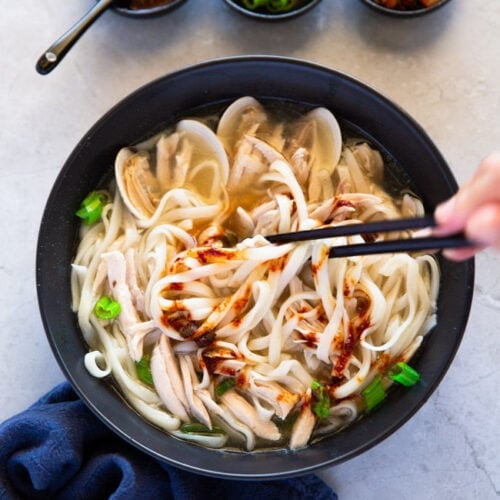
Korean Chicken Noodle Soup (Dak Kalguksu)
Ingredients
SOUP BASE
- 1 kg chicken backs (chicken frames), (2.2 pounds)
- 110 g onion (3.9 ounce)
- 50 g green onion (1.8 ounce), white part
- 15 g garlic cloves (0.5 ounce)
- 50 g dried anchovies (1.8 ounce)
- 1/2 tsp whole black peppers
- 12 cups water
MAIN
- 1 kg chicken drumsticks (2.2 pounds)
- 300 g little neck clams (10.6 ounce), rinsed
- 400 g kalguksu noodles (or udon noodles, *see above for more options), (14.1 ounce)
- 1 tsp Korean soup soy sauce or regular kikkoman soy sauce
- 3/4 tsp fine sea salt , or to your taste
TOPPING (OPTIONAL)
- 30 g green onion (1 ounce), thinly sliced
SEASONING SAUCE (OPTIONAL)
- 1/4 cup soy sauce , regular (I use kikkoman brand.)
- 1 Tbsp Korean chili flakes (gochugaru)
- 1/2 Tbsp honey
- 1 Tbsp green onion , thinly sliced
- 1 tsp minced garlic
- 1 tsp sesame oil
Instructions
- Place the chicken backs in a large pot along with the other soup base ingredients and water. To make cleanup easier later, you can use a stock bag (also called a soup sock), typically made of fine mesh or cheesecloth, to hold the solid ingredients. If your bag isn’t large enough to fit everything, focus on enclosing the anchovies, garlic, and black pepper—these are the trickiest to remove later.Bring everything to a boil over medium-high heat, which should take about 25 minutes. Once it reaches a boil, carefully add the chicken drumsticks to the pot. Continue cooking at the same heat for another 25 minutes.
- Lower the heat to medium-low and let the broth simmer for another 30 minutes. Skim off any foam or fat that rises to the surface to keep the broth clear.
- Remove the soup base ingredients from the broth. Set the chicken drumsticks aside in a separate bowl to cool. Once cooled, remove the skin and bones, then tear the meat into bite-sized pieces. Set aside until ready to serve.
- In another large pot, pour in the broth and bring it to a boil. Add the littleneck clams and Korean soup soy sauce, then season with salt to taste.
- Briefly rinse the kalguksu noodles under cold running water to remove excess starch. Add them to the boiling broth and cook over medium heat for 3–5 minutes, or until fully cooked.
- Meanwhile, mix the optional seasoning sauce ingredients in a small bowl and set aside.
- Serve the soup piping hot, topped with the prepared chicken and green onions. You can enjoy it as is, or add a spoonful of the seasoning sauce to enhance the flavor to your taste.
Notes
- 1 Tbsp = 15 ml, 1 Cup = 250 ml
- If you’re interested in learning more about Korean ingredients, check out my essential list of Korean cooking ingredients.
- Kalguksu pairs perfectly with kimchi—especially fresh kimchi salad or radish kimchi (kkakdugi) for crunch and brightness.
Nutrition Info (per serving)
The nutrition information shown is an estimate provided by an online nutrition calculator. It should not be considered a substitute for a professional nutritionist’s advice.
